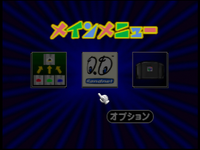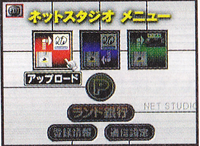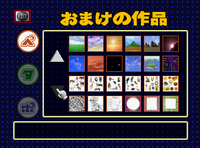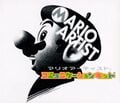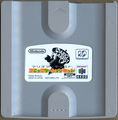Mario Artist: Communication Kit
The title of this article is from the English Super Mario Bros. Encyclopedia, which reportedly sourced some names from fan wikis.
If a higher-priority source is found, then the article should be moved to the new title.
| Mario Artist: Communication Kit | |
|---|---|
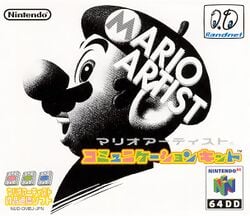
| |
| Developer | Nintendo EAD |
| Publisher | Nintendo |
| Platform | 64DD |
| Release date | |
| Genres | Application, Add-On |
| Mode | Single player |
| Format | 64DD:
|
| Input | Nintendo 64:
|
| Serial code | NUD-DMBJ-JPN |
Mario Artist: Communication Kit is software that served as an accessory in the Mario Artist series for the 64DD. Like the other titles, it was released only in Japan on June 27, 2000.[1] It allowed players to upload and download creations from the games via the Randnet service, backup their creations, and save images taken from videos with the Capture Cassette. The player can also find pre-made content that they can download to the other three games via a secret option in the menu.
Overview[edit]
Controls[edit]
- In the menus
| Action(s) | Input(s) |
|---|---|
| Move cursor | |
| Select icons Advance page |
|
| Return page | |
| Move cursor to exit button | |
| Toggle thumbnail loading during download | |
| Act as the |
- In Capture de Asobu
| Action(s) | Input(s) |
|---|---|
| Change continuously | |
| Change step-by-step | |
| Return to icon selection screen | |
| Save frame as image | |
| Toggle between black and white and color |
Modes[edit]
Mario Artist: Communication Kit features three main modes: Save and Load (「セーブ・ロード」, Sēbu Rōdo), Net Studio (「ネットスタジオ」, Netto Sutajio), and Capture de Asobu (「キャプチャーで遊ぶ」, "Play with Capture"). Save and Load allows players to backup their creations from the Mario Artist games and use them with Communication Kit or save creations to the other games. Net Studio allowed them to share their creations with Randnet users, download other users' creations, send a creation to RandnetDD for printing, and participate in events. Lastly, Capture de Asobu allows the player to use the Capture Cassette to play a video with a filter applied and save images from it.
Net Studio[edit]
This section is about a work that used to be available to the public, but is now partially or entirely inaccessible. Details: The service was discontinued on February 28, 2001 and is no longer accessible.
However, the subject is thoroughly documented here. Only remove this notice if the complete work is recovered and made available publicly.
Net Studio was accessible from the main menu by connecting the Modem to the Nintendo 64, and required a Randnet subscription to access. After connecting to Randnet, the user could access the Upload (「アップロード」, Appurōdo), Download (「ダウンロード」, Daunrōdo), and Print Service (「プリントサービス」, Purinto Sābisu) options. The menu also allowed the user to set up to five pen names to use when uploading creations, manage network settings, and purchase "Rand Cash" (「ランドキャッシュ」, Rando Kyasshu), Randnet's currency. A version of Net Studio with a message board was accessible via the Randnet disk. Due to the discontinuation of Randnet on February 28, 2001, this mode is no longer accessible.
Print Service[edit]
Print Service was an option in the main menu of Net Studio that allowed an user to pay to upload their creation to Randnet and have it printed and sent to them. Users could either choose to have one or multiple pictures printed as a set of stickers or a model created in Mario Artist: Polygon Studio turned into a papercraft kit.
Net Gallery[edit]
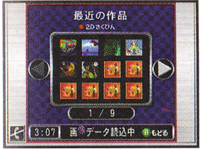
Net Gallery (「ネットギャラリー」, Netto Gyararī) was a menu in Net Studio. In Download, users could use this menu to view a gallery of other users' creations and download them to Save and Load. In Upload, users could give descriptions to their creations and upload them to the public after being reviewed by RandnetDD.
Kōkan Box[edit]
Kōkan Box (「交換ボックス」, "Exchange Box") was a menu in Net Studio where users could privately send creations to each other. When a creation was uploaded in this menu, a creation ID and a password were generated, which could then be given to another user to allow them to download the creation. The creation was removed once it was downloaded.
Event[edit]
Event (「イベント」, Ibento) was a menu in Net Studio where it was possible to participate in events organized by RandnetDD. Users could either upload their creations to participate in an event or download featured and winning creations from past events. According to the game's manual, some events would have required paying to upload or download creations, although no events with this requirement ended up being hosted. Only three events have been hosted:
- Mario Artist Kōshien (マリオアーティスト甲子園): Hosted from July 2000. Participants could upload creations created in Mario Artist: Paint Studio or Mario Artist: Talent Studio in specific categories, which were then reviewed by a panel of judges that included radio personality Hikaru Ijūin and manga artist Anko Mochizuki. The prizes included a 30,000 yen gift certificate and a trip to Hollywood.[2][3]
- Game Creator e no Chōsenjō (GAMEクリエイターへの挑戦状, "Challenge to the Game Creators"): Hosted from October 26 to November 6, 2000. Participants could upload creations made in the Mario Artist games and have the series' developers comment on them.[2]
- Sotsugyō Shashin & Yosegaki Tsukurō! (卒業写真&よせ書きつくろう!, "Let's Make a Graduation Photo & Yosegaki!"): Hosted near the discontinuation of Randnet. In addition to sending a message, participants could upload one of their creations to have it featured on a "graduation photo". The photo was sent to participants after the discontinuation.[2]
Capture de Asobu[edit]
Capture de Asobu is accessible from the main menu by connecting a device to the Nintendo 64 with the Capture Cassette. In this mode, the player can select one out of eleven effects to then apply it to a video. The player can also save an image from a video frame to Save and Load.
Omake no Sakuhin[edit]
This section is a stub. Please consider expanding it to include any missing information. Specifics: List all downloadable works
Omake no Sakuhin (「おまけの作品」, "Bonus Works") is a hidden menu accessible from the game's main menu. Its icon is located on the bottom of the screen, next to the settings button, and is only visible when hovering over it. In it, the player can download to Save and Load a collection of creations for all three Mario Artist games, including artwork from The Legend of Zelda: Majora's Mask. Once selected, the menu's icon becomes always visible in the main menu until the game is reset.
Staff[edit]
- Main article: List of Mario Artist: Communication Kit staff
Pre-release and unused content[edit]
The Game Boy Printer would have been able to be connected to Mario Artist: Communication Kit via the unreleased 64GB Cable peripheral. Once connected, a new Printer (「プリンター」, Purintā) option would have appeared in the main menu. This menu would have allowed the user to print saved images in different directions, split images, and change the paper color, brightness, and contrast. The menu also supports an unreleased "Game Boy Printer Color" peripheral, and includes settings for brightness, contrast, and hue.[4]
Gallery[edit]
References to other games[edit]
- Artwork of characters from this game can be downloaded from Omake no Sakuhin for Mario Artist: Paint Studio.
Names in other languages[edit]
| Language | Name | Meaning | Notes |
|---|---|---|---|
| Japanese | マリオアーティスト コミュニケーションキット[5] Mario Ātisuto: Komyunikēshon Kitto |
Mario Artist: Communication Kit |
References[edit]
- ^ a b Sakai, Kazuya (Ambit), et al. (October 19, 2015). 『スーパーマリオブラザーズ百科: 任天堂公式ガイドブック』(Super Mario Bros. Hyakka: Nintendo Kōshiki Guidebook). Tokyo: Shogakukan (Japanese). ISBN 978-4-09-106569-8. Page 243.
- ^ a b c ランドネットの企画. 64DD Laboratory (Japanese). Retrieved October 18, 2025. (Archived February 6, 2025, 23:10:18 UTC via Wayback Machine.)
- ^ Meubish (January 17, 2020). 64DD ゲームコンテスト マリオアーティスト甲子園で入賞. Ameblo (Japanese). Retrieved October 18, 2025. (Archived October 18, 2025, 19:39:35 UTC via archive.today.)
- ^ Mario Artist Communication Kit § Game Boy Printer Support. The Cutting Room Floor. Retrieved October 19, 2025.
- ^ Box art
| Nintendo 64 games | |
|---|---|
| Super Mario franchise | Super Mario 64† (1996) • Mario Kart 64† (1996) • Mario no Photopi (1998) • Mario Party (1998) • Mario Golf (1999) • Mario Artist: Paint Studio* (1999) • Mario Party 2 (1999) • Mario Artist: Talent Studio* (2000) • Mario Artist: Communication Kit* (2000) • Mario Tennis (2000) • Paper Mario† (2000) • Mario Artist: Polygon Studio* (2000) • Mario Party 3 (2000) • Dr. Mario 64† (2001) |
| Donkey Kong franchise | Diddy Kong Racing (1997) • Donkey Kong 64 (1999) |
| Yoshi franchise | Yoshi's Story† (1997) |
| Crossovers | Super Smash Bros.† (1999) |
